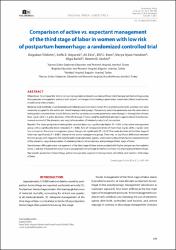| dc.contributor.author | Yıldırım, Doǧukan | |
| dc.contributor.author | Özyürek, Şefik Eser | |
| dc.contributor.author | Ekiz, Ali | |
| dc.contributor.author | Eren Çiler, Elif | |
| dc.contributor.author | Hendem Uyan, Derya | |
| dc.contributor.author | Bafalı, Olgu | |
| dc.contributor.author | Seçkin Doğa, Kerem | |
| dc.date.accessioned | 2020-07-14T10:21:55Z | |
| dc.date.available | 2020-07-14T10:21:55Z | |
| dc.date.issued | 2016 | en_US |
| dc.identifier.citation | Yıldırım, D., Özyürek, Ş. E., Ekiz, A., Eren Çiler, E., Hendem Uyan, D., Bafalı, O. ve Seçkin Doğa, K. (2016). Comparison of active vs. expectant management of the third stage of labor in women with low risk of postpartum hemorrhage: A randomized controlled trial. Ginekologia Polska, 87(5), 399-404. https://dx.doi.org/10.5603/GP.2016.0015 | en_US |
| dc.identifier.issn | 0017-0011 | |
| dc.identifier.uri | https://dx.doi.org/10.5603/GP.2016.0015 | |
| dc.identifier.uri | https://hdl.handle.net/20.500.12511/5485 | |
| dc.description.abstract | Objectives: To compare the ‘strictly’ active management protocol in women with low risk of postpartum hemorrhage using the expectant management protocol with respect to changes in hematologic parameters, uterotonics, blood transfusions, or additional interventions. Material and methods: A randomized controlled prospective trial in which 934 singleton parturients enrolled; 654 were randomly assigned to the active and mixed management groups. The primary outcome parameter was the reduction in hemoglobin concentrations due to delivery, and the secondary outcome parameters were changes in hemoglobin of more than 3 g/dL (∆Hb ≥ 3 g/dL), durations of the third stage of labor, need for additional uterotonic agents, blood transfusions, manual removal of the placenta, and surgical evacuation of retained products of conception. Results: The mean postpartum hemoglobin concentration was significantly higher (P = 0.04) in the active management group with a significantly lower reduction (P = 0.03). Falls of hemoglobin levels of more than 3 g/dL (∆Hb ≥ 3g/dL) were less common in the active management group though not significantly (P = 0.32). The mean duration of the third stage of labor was significantly (P < 0.001) shorter in the active management group. There was no significant difference between the two groups with regard to the need for additional uterotonic agents, uterine atony, blood transfusion, manual removal of the placenta, surgical evacuation of retained products of conception, and prolonged third stage of labor. Conclusions: Although active management of the third stage of labor was associated with higher postpartum hemoglobin levels, it did not influence the risk of ‘severe postpartum hemorrhage’ in women with low risk of postpartum hemorrhage. | en_US |
| dc.language.iso | eng | en_US |
| dc.publisher | Via Medica | en_US |
| dc.rights | info:eu-repo/semantics/openAccess | en_US |
| dc.subject | Postpartum Hemorrhage | en_US |
| dc.subject | Active Management | en_US |
| dc.subject | Expectant Management | en_US |
| dc.subject | Controlled Cord Traction | en_US |
| dc.subject | Third Stage of Labor | en_US |
| dc.title | Comparison of active vs. expectant management of the third stage of labor in women with low risk of postpartum hemorrhage: A randomized controlled trial | en_US |
| dc.type | article | en_US |
| dc.relation.ispartof | Ginekologia Polska | en_US |
| dc.department | İstanbul Medipol Üniversitesi, Tıp Fakültesi, Cerrahi Tıp Bilimleri Bölümü, Kadın Hastalıkları ve Doğum Ana Bilim Dalı | en_US |
| dc.identifier.volume | 87 | en_US |
| dc.identifier.issue | 5 | en_US |
| dc.identifier.startpage | 399 | en_US |
| dc.identifier.endpage | 404 | en_US |
| dc.relation.publicationcategory | Makale - Uluslararası Hakemli Dergi - Kurum Öğretim Elemanı | en_US |
| dc.identifier.doi | 10.5603/GP.2016.0015 | en_US |
| dc.identifier.wosquality | Q4 | en_US |
| dc.identifier.scopusquality | Q3 | en_US |


















